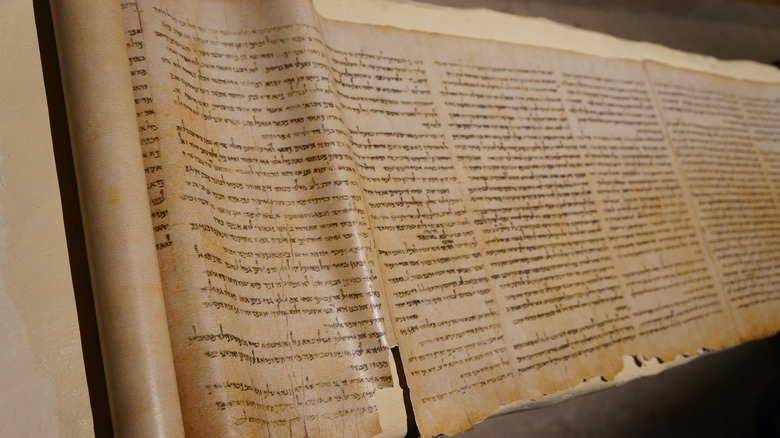Do Any Original Manuscripts Of The Bible Still Exist?
The Bible is an extensive collection of books written at different times. (via the BBC). It is split into two sections, the Old Testament and the New Testament. The Old Testament, written approximately between 1200 and 165 B.C., includes texts primarily written by Jewish authors and includes historical documentation, family trees, laws, and scriptures that the Jewish faith adheres to. The New Testament was written by Christians, the followers of Jesus, who believed that he was the Messiah. The New Testament was composed in the first century A.D.
Because the Bible was written over such a long period of time, with the last book being written nearly 2,000 years ago, there are no known original copies. While extremely old manuscripts have been discovered, the original writings of its authors have been lost to time. Nevertheless, many of the books that exist today still present historical events with a high degree of accuracy, primarily thanks to the work of Jewish scribes who meticulously copied their religious texts (via Scott Manning).
Most ancient Biblical texts were written on perishable materials
One of the biggest contributors to the lack of original manuscripts of the Bible has to do with the fact that these manuscripts were primarily written on perishable materials. It would have been difficult to carve entire books into stone, so most of it was written on paper-like materials like papyrus and parchment. Papyrus was made from reeds that grow along the Nile river, while parchment was made out of animal skin (via Houston Baptist University).
These perishable materials may have lasted a while, but the last book of the Bible would have been written 1,900 years ago. Even the most durable form of paper would eventually start to break down over such a long period of time (via Blue Letter Bible). This is a problem archaeologists have when trying to find original copies of many famous ancient texts. Simply put, manuscripts can only last so long before they begin to disintegrate.
Ancient scribes were required to bury old texts after they copied them
When Jewish scribes took on the painstaking process of copying old texts onto new parchment, they had to follow many rules to ensure the manuscripts were copied correctly. After they were checked for mistakes, the old manuscripts were no longer needed, as they were worn and would soon be unreadable. Because the Jewish faith requires that no copy of the Bible be destroyed, the original manuscripts were buried in a genizah, meaning "hiding place," to keep them from being defiled by enemies (via Scott Manning).
This process of hiding original manuscripts by burying them has resulted in no such documents being found by modern archeologists, as they have surely decomposed by now. While this form of getting rid of old texts was only required for Jewish scribes during copying of the Old Testament, it is possible that copiers of the New Testament followed a similar tradition. This, in addition to the length of time that has passed since the last book was written, could help to explain the lack of original copies.
The history of Israel is laden with difficulties that resulted in lost texts
The Jews have consistently dealt with many difficulties throughout their long history. They have been kicked out of their homelands, captured and forced into slavery, had to travel long distances for many years, and been repeatedly mistreated by other societies from the time the Old Testament was written even into the modern day. As such, many manuscripts were lost, destroyed by enemies, or had to be abandoned when fleeing danger.
In addition to Old Testament manuscripts being destroyed, many copies of the New Testament saw destruction throughout their history. One church historian, Eusebius, witnesses and documented the destruction in his "Ecclesiastical History," stating, "we saw with our own eyes our houses of worship thrown down from their elevation, the sacred Scriptures of inspiration committed to flames in the midst of the markets." Many of these texts were destroyed by those who wanted to stop the spread of Christianity in its early history (via Blue Letter Bible).
The oldest collection of manuscripts was preserved in caves
Although the original manuscripts no longer exist, there are copies of Biblical writings, some of them quite ancient. The oldest collection of Old Testament manuscripts was found in 1947 in the caves around Qumran near the Dead Sea. These manuscript fragments and scrolls were found in 11 caves in the area between 1947 and 1956. They contained copies of nearly every book of the Old Testament, with the exception of two books, Nehemiah and Esther. These manuscripts have been dated from the third century B.C. to the first century A.D. Some of the earliest copies are estimated to be from around 250 B.C.
These ancient scrolls allowed archaeologists to compare current copies with these older texts, as they had been left untouched in the caves for thousands of years. What they found were nearly identical to modern day books, showing little to no change over thousands of years of copying texts to replace worn manuscripts. This shows how much time and effort ancient scribes put into copying and replacing texts throughout the Jewish history (via Bible Archaeology Report).
Even without the original texts, the Bible is often historically accurate
One method that archaeologists use to determine if ancient texts and objects are historically accurate is to compare them to known events, other historical works, and archaeological sites. This allows archaeologists to verify key information and determine if the text is giving an accurate account of something that took place. The Bible is often regarded as an accurate historical document when it comes to several historical events that happened during its writing.
Many books of the Bible are historical records of events and family trees, and the authors of these books took great care to document these events accurately. Archaeologists have been able to confirm many events that have been recorded in some of the books of the Bible through other ancient texts, recovered objects, and historical sites. These books are useful for cross-verifying historical events and timelines (via Bible.org). Without original copies of the Bible, it is hard to confirm some of the information it contains, but the work archaeologists perform helps us to learn more about the accuracy of historical information presented in these religious texts.





